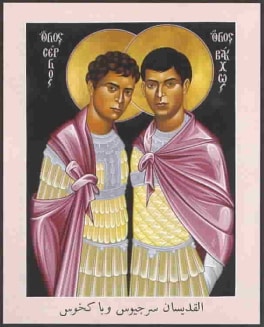Same Sex Medieval Marriage – Dr Marshall Reveals the Fraud
Pssst. Did you know that the medieval Catholic and Orthodox churches had a liturgy for same-sex unions and that the contemporary Church is doing everything it can to erase the historical record?

This is the claim of the homosexual historian John Boswell in his book Same Sex Unions in Pre-Modern Europe (Chicago).
Same Sex Marriage Liturgy = Adelphopoesis?
Boswell’s argument hinges on the existence of a liturgical ritual called adelphopoiesis. Adelphos means “brother.” Poesis means “making.” So the term in Greek literally means “brother-making.”
Now Boswell translated adelphopoesis as “same-sex union,” and made the case that these were homosexual unions sanctioned by the Church. You don’t have to be a great Greek scholar to get the agenda. Adelphopoesis most certainly does not translate as “same-sex union.”
Along the same lines, Allan Tulchin in his article “Same-Sex Couples Creating Households in Old Regime France: The Uses of the Affrèrement,” (Journal of Modern History: September 2007) made his case that Latin liturgy of affrèrement (Latin title is Ordo ad fratres faciendum, literally “Order for the making of brothers”) was a medieval “same-sex union” recognized by Europe and the Church. Affrèrement allowed two men to share living quarters, pool their finances, and have recognition from the state and church as an economic unit.
To muddy the waters, same-sex marriage advocates have coupled Saint Sergius and Saint Bacchus as the patron saints of this alleged arrangement. These two men were known in Byzantine history to be holy men with a great brotherly affection for one another. They are mentioned in the Greek liturgy of adelphopoesis, and Boswell argues that they were likely an early same-sex pair joined together in homoeroticism.
Regrettably, modern scholars feel that sexuality must be the incentive for any relationship in history. David and Jonathan or Sergius and Bacchus are “proof” that religious male friends were secret lovers between the pages of history.
Adelphopoesis or Affrèrement was Not Homoerotic
Boswell’s analysis fails when we recall that both Catholic Europe and Orthodox Byzantium punished homosexuality with death (Byzantine codes of law call for convicted homosexual men to be burned). Boswell is right, though. There is ample evidence of homosexuality in the medieval era. Unfortunately for him, the Christian and liturgical norms never reveal the slightest tolerance for homosexual acts.
In the middle of the 1000’s you have Saint Peter Damian’s book Liber Gomorrhianus circulating with a crying condemnation of both homosexuality and masturbation among the clergy.
Saint Hildegard of Bingen in the 1100s wrote against lesbian acts in her work Scivias.
The same condemnation against homosexuality is reiterated in penitential manuals and again by Saint Thomas Aquinas in the 1200s. In the 1300s, the heretical reform sect of the Lollards in England cited priestly celibacy as a cause of homosexuality in society.
Saint Peter Damian and Saint Hildegard’s explicit teachings over explicit acts certainly reveal that homosexuality was practiced among the laity, the clergy, and the religious – even the women religious. So Boswell is correct in identifying homosexual activity in his period. He is simply wrong in pointing to adelphopoesis as a sanctioned form of homosexuality.
It would be odd for both a civil society and a universal religion to criminalize homosexual acts on one hand, but also provide a “wink-wink” liturgy in order to establish a sexual relationship between two men on the other hand.
Understanding Adelphopoesis as a Kind of Monasticism
The formation of a social unit in which food, finances, and shelter are shared is not unique to matrimony. The Christian tradition also established monastic brotherhoods where men would gather to share all possessions, income, and shelter equally. These social units were protected liturgically, ecclesiastically, and civilly.
Adelphopoesis is the same kind of arrangement – but more suited for two men who wished to live in the world. The liturgies for Adelphopoesis or Affrèrement from the ninth to the fifteenth centuries establish pneumatikous adelphous or “spiritual brothers.” Chastity is assumed. If the Emperor Theodosius ruled that homosexual acts received the punishment of being burned to death, I don’t think that such a society would have assumed that “spiritual brothers” were anything more than consecrated men pooling their resources for the common good.
Could the arrangement of adelphopoesis be abused by homosexual men seeking to find a civil form of tolerance? Of course! Did it ever happen. Probably. Men have used monasteries to cloak improprieties and escape the glare of the society. Read Chaucer’s Canterbury Tales for more details.
The take away is that adelphopoesis never was intended to be a “same-sex marriage” for homosexuals, even if Boswell translated it that way…
[reminder]Had you heard of this debate over adelphopoesis? Are you now able to explain the truth about it?[/reminder]
Please share this post on Facebook.
What to Watch Next
SHOP THE TAYLOR MARSHALL STORE
Dive Deeper

GET CONFIDENT IN YOUR FAITH
Explore the fascinating world of Catholic teachings with Dr. Marshall. Together you’ll unpack the brilliant answers the Church gives to tough questions about the Faith. The best part: you go at your own pace. Start this exciting journey today.


 >
>



